Personality and Aptitude assessments are a popular tool used in the workplace. They can help identify an individual’s natural strengths, areas of opportunity, and their preferred way to absorb the world around them and communicate what they see.
Organizations can use these assessments to understand how individuals can better collaborate with each other, both within teams and across the company. Team leaders can also create a starting point for an employee’s developmental growth and provide a roadmap to success that is tailored to the communication style of each individual.
With a variety of assessments in the marketplace, how can you determine which is best for your organization?
First we need to break down the mind into its three basic features:
- Cognitive – Your mind’s intelligence or knowledge; what you can or cannot do
Assessments: IQ and Predictive Index - Affective – Your mind’s attitudes, beliefs, or values; what you want and do not want to do
Assessments: Myers-Briggs and DISC - Conative – Your mind’s instinct or natural energy; what you will or will not do
Assessments: Kolbe Index, DISC and Predictive Index
Common Assessments in the Workplace
Myers-Briggs Personality Type Indicator
Myers-Briggs Personality Type Indicator is one of the oldest personality assessments and one of the most popular. Isabel Myers and Katherine Briggs developed this questionnaire based on their work with Carl Jung’s Theory of personality types. This questionnaire is designed to identify one’s personality type, strengths and preferences.
MBTI is composed of four categories:
- Extraversion (E) vs. Introversion (I) – How one responds and interacts with the world around them
- Sensing (S) vs. Intuition (N) – How one gathers information from the world around them
- Thinking (T) vs. Feeling (F) – How one makes decisions based on information that was previously gathered
- Judging (J) vs. Perceiving (P) – How one tends to deal with the outside world
Myers-Briggs 16 Personality Types
| INFP The Healer |
INTJ The Mastermind |
INFJ The Counselor |
INTP The Architect |
| ENFP The Champion |
ENTJ The Commander |
ENTP The Visionary |
ENFJ The Teacher |
| ISFJ The Protector |
ISFP The Composer |
ISTJ The Inspector |
ISTP The Craftsperson |
| ESFJ The Provider |
ESFP The Performer |
ESTJ The Supervisor |
ESTP The Dynamo |
DISC
DISC is another assessment that has been around for many years and also finds its roots from Carl Jung’s research. Because of its accuracy and ease-of-use in the field, approximately 70% of Fortune 500 companies use DISC within their organization along with many small businesses, universities, and college programs. DISC is a self-assessment based on psychologist William Moulton Marston’s continued psychological research and identifies how people prefer to communicate and interact with others. By identifying a person’s dominant behavioral and communication style, DISC helps users understand general motivations, strengths, and areas of opportunities for themselves and the people they collaborate with.
The DISC Model focuses on four dominant behavior types:
- Dominance: This style puts emphasis on accomplishing results and is often confident, outspoken, assertive, and decisive
- Influence: This style is often skilled at influencing or persuading others and tends to be optimistic, open, enthusiastic, and energetic.
- Steadiness: This style emphasizes cooperation, sincerity, and dependability. They also tend to have calm and deliberate dispositions.
- Conscientiousness: This style values quality and accuracy and tends to enjoy their independence and be detailed-oriented.
Predictive Index
Predictive Index is a theory-based, self-report that most organizations use to measure abstract intelligence and personality of future employees. The Predictive Index Assessment is a two-part test, one that tests cognitive ability and one that tests behavioral traits.
The Predictive Index Cognitive Ability assessments will test individuals problem-solving skills and how fast one processes information.
The Predictive Index Behavioral Assessment is a tool that employers can use to understand the prospective employee’s personality and if they’re a right fit for the position. Predictive Index Behavioral Assessment measures four behavioral drives:
- Dominance: The drive to exert influence on people or events
- Extraversion: The drive for social interaction
- Patience: The drive to have consistency and stability
- Formality: The drive to conform to rules and structure
Kolbe A Index
The Kolbe A Index is different from the previous assessments listed above. It does not measure intelligence, personality, or social style, but measures instinctive ways one takes action. This assessment is designed to measure people’s actions in a particular situation and behaviors driven by instinct. After taking the assessment, the participant receives a score in the four Kolbe Action Modes:
- Fact Finder – The instinctive way we gather and share information
- Follow Thru – The instinctive way we arrange and design
- Quick Start – The instinctive way we deal with risk and uncertainty
- Implementor – The instinctive way we handle space and tangibles
Why Does Benchmark Training Use DISC Over All Personality Tests?
When it comes to these assessments, there are no right or wrong answers or results that are better or worse. These assessments uncover and identify similar things, but their true value shines through when they are used effectively and daily such as how to communicate better with clients and colleagues, as well as developing yourself and the team.
Field Application
Even though MBTI and Predictive Index are great assessment tools for an individual seeking self-knowledge and an understanding of the world around them, they both focus on personality rather than behavior. Personality is internal and MBTI and Predictive Index allow the individuals to look inward, while DISC focuses on behaviors that are external and how we choose to interact with our environment. By identifying one’s current behaviors and communication preferences, it is easier to adapt and more effectively communicate with others.
Ease of Use
A common limitation of MBTI and Predictive Index is that both assessments have a large category of results, with 16 MBTI types and 17 Predictive Index Personality Types.
While the results will offer some additional detail, the many challenges and obstacles team members experience in the workplace make it difficult for them to remember and therefore apply when needed.
DISC is based around the four styles of human behavior and lays the foundation to better understanding between team members. For obvious reasons, DISC users who have also taken other assessments feel it is easier to remember and implement four styles than 16-17 and therefore find themselves actually using the concepts in the workplace.
Because DISC takes a complex and complicated subject, like communication and human behaviors, and turns it into something that is simple and easy to learn and utilize, Benchmark clients feel confident to use DISC across the entire organization as a tool to break down communication and collaboration silos. Simply put, DISC is easy to learn, easy to implement and can therefore more significantly impact day-to-day activities.
Why Utilize DISC
DISC can be used to create a common language within an organization and increase collaboration, productivity and efficiency. Organizations that use DISC find it easier to deepen their culture and find it easier to take on the challenges in today’s market. When a team finds it easier to work together, the organization’s culture becomes the organization’s competitive advantage.
Take a look at how Benchmark Training uses Extended DISC with our clients of all sizes: Click Here!




